Showing 25–36 of 41 results
-
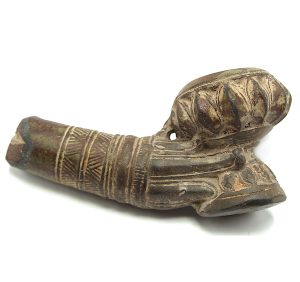
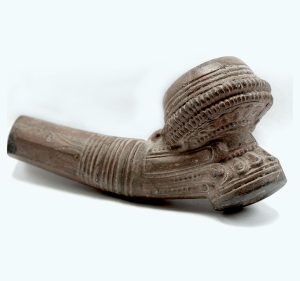
$85.00
H: 2” W: 1.75” D: 4” | FREE SHIPPING!
Antique and vintage ceramic tobacco pipes are part of a long cultural tradition of Burmese/Myanmar and Thai hill tribes. Mould made and adorned with intricate designs, a bamboo or metal stem was often inserted at the end through which smoke was drawn. This highly collectible antique item reflects hill-tribe skills creating decorative functional objects and would be a unique gift for any pipe smoker, but, like all antique items, we recommended it be used as a decorative item.
-
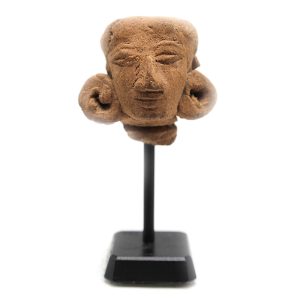
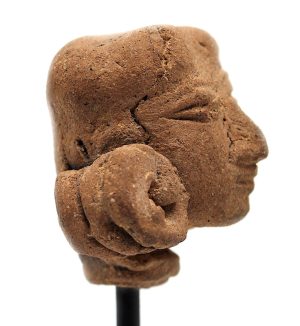
$195.00
Ht: 2.75” W: 1.375” D: 1.125” | FREE SHIPPING!
This terracotta head was crafted during the Majapahit Empire in Java and was either part of a bas-relief frieze or made as a freestanding figurine. Most figures found are small decapitated heads with no bodies, and it is very rare to find a complete figure with a naturalistic facial expression. As with many heads, this one displays Javanese facial features, hairstyles and ear ornamentation typical of the period. It has a naturalistic facial expression and wears large round coiled earrings, possibly suggesting it represented someone of the upper classes. It is in very good condition given its age and use and is mounted on a metal stand. This item pairs with Majapahit Miniature Terracotta 1138.
-
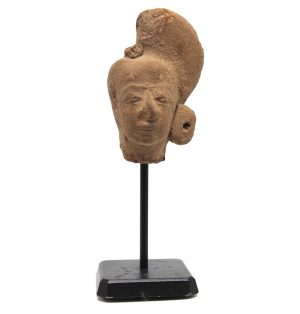
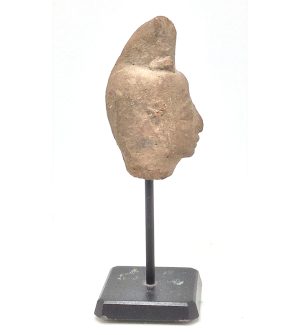
$195.00
Ht: 4” W: 1.5” D: 1.75” | FREE SHIPPING!
This terracotta head was crafted during the Majapahit Empire in Java and was either part of a Hindu bas-relief frieze or made as a freestanding figurine. Most figures found are small decapitated heads with no bodies, and it is very rare to find a complete figure with a naturalistic facial expression. As with many heads, this one displays Javanese facial features, hairstyles and ear ornamentation typical of the period. It has a naturalistic facial expression and wears large round coiled earrings, possibly suggesting it represented someone of the upper classes. It is in very good condition given its age and use and is mounted on a metal stand. This items pairs with Majapahit Terracotta Head 1137.
-
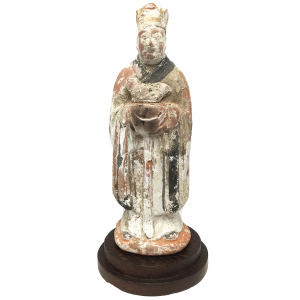
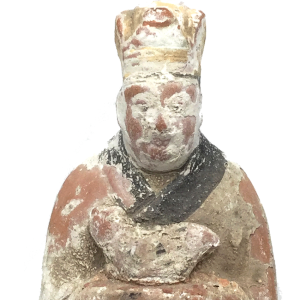
$395.00
H: 7.375” W: 2.75” D: 2.5” | FREE SHIPPING!
A group of 12 zodiac figures as mingqi sometimes accompanied the wealthy deceased in their tomb. This Ming dynasty earthenware figurine stands on a low circular base and wears an official’s hat and long flowing robes. It is difficult to identify the specific animal held here but it may be a rabbit, small dog or baby pig. The detailed figure is hollow and partially mould-made and unlike glazed mingqi, was covered with a white slip and painted using black and white pigments which are mostly extant.
-
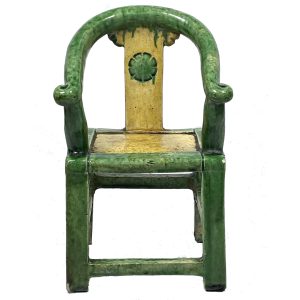
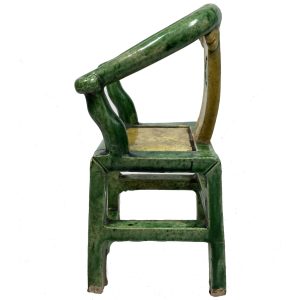
$685.00
H: 7.375″ W: 4.375″ D: 3.75″ | FREE SHIPPING!
Often ancestral figures were portrayed sitting in horseshoe chairs to reflect the high status of the figure they were portraying. As many earthenware mingqi, this well-modeled chair has a liberally applied thick green glaze resulting in expected drips around the stretchers. The seat is decorated with a yellow glaze imitating caning and the decorative carved design on the splat also has a yellow glaze and a carved decorative “clocklike” circular design. The bottom of the seat and legs are not glazed, as is usual. It is in very good condition with expected minor chips and minor glaze pitting and deterioration consistent with its age and long burial. It pairs perfectly with item 3330 and together would add to a fine collection of Chinese ceramics.
-
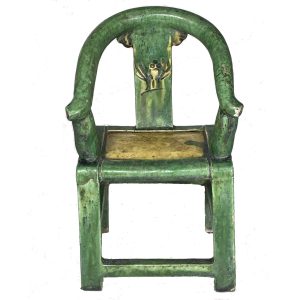
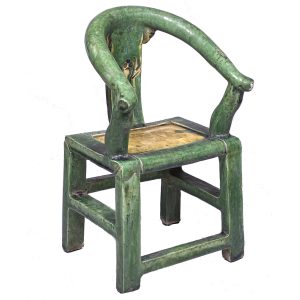
$685.00
H: 7.375″ W: 4.375″ D: 3.75″ | FREE SHIPPING
This charming miniature Ming dynasty ceramic horseshoe pottery chair is an accurate model of an impressive Ming chair that would have been made of a beautifully grained hardwood and constructed with a continuous horseshoe shaped top rail and a caned seat. The curved splat of a wood chair might have either carved or pierced motifs or medallions and straight or curved stretchers joining the legs in pairs at the same height on each side. Often ancestral carved figures were portrayed sitting in horseshoe chairs to reflect the high status of the figure they were portraying. This ceramic mingqi has a thick green glaze throughout which was liberally applied normal usual drips around the stretchers. The seat is decorated with a yellow glaze in imitation of caning as is the decorative carved design on the splat, but the bottoms of both the seat and legs are unglazed. The rail ends splay to the right and left for hand comfort and decorative effect are traditionally found in Ming Dynasty hardwood horseshoe-shaped chairs. It is in very good condition with minor chips and paint losses and fading due to its being buried underground in a tomb for centuries. It would be a fine addition to a collection of antique ceramics.
-
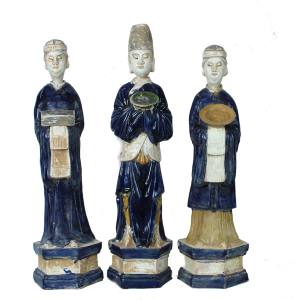
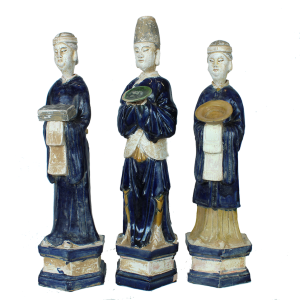
$4,985.00
H: 17.875″ W: 4.875″ D: 4.75″ | FOR SHIPPING INFORMATION CONTACT US AT 213-568-3030
This brilliant set of three Ming dynasty attendants – one male and two female – are in a unique category of refinement and elegance that reflects the importance and high status of the tomb, the deceased and the family that commissioned them. Standing on hexagonal bases with arms folded below their chests and presenting offerings to the deceased, their clothing and parts of the bases have a rare cobalt blue glaze for burial objcts, two have yellow glazed areas and all have painted unglazed areas. Their removable heads are highly detailed and beautifully modeled fitting inside high collars. These figures are presented and sold as a remarkable set reflecting their original presentation and condition.
-
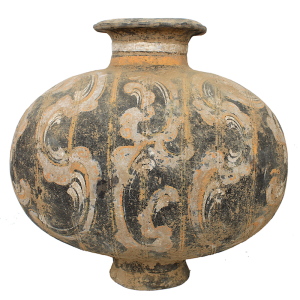
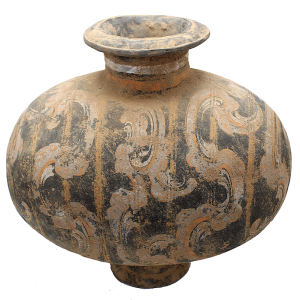
$2,100.00
H: 11.75” W: 12.25” D: 7.5” | FOR SHIPPING INFORMATION CONTACT US AT 213-568-3030
Cocoon jars were mingqi made for placement in tombs to comfort the deceased on their journey to and in their afterlife. An elixir of Immortality made from mulberry leaves or their ashes was placed inside for the deceased to drink and transmigrate into the world of the beyond. Ovoid in shape to resemble a silkworm cocoon, ajar rests on a small trumpet-shaped foot and has a narrow neck and a wide lip at its mouth. Painted after firing with vertical bands dividing it into panels, swirling cloud scrolls, and circular “eye” motifs at each end, this beautiful vessel is in excellent condition for its age with expected paint losses, scrapes, and dirt adhesions.
-
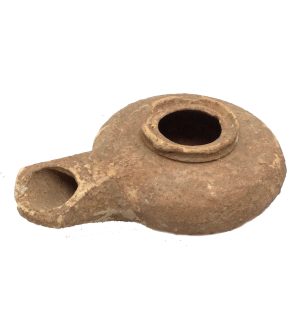
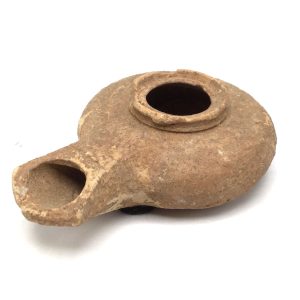
$155.00
SOLD
This Roman catacomb terracotta oil lamp is a basic, undecorated, and functional lamp beautiful in its simplicity. It is a well moulded piece with a finely rounded circular body, a short raised rim surrounding the fill hole centered in the middle, and has a hand made spatulate nozzle added to its body. The nozzle extends out with flat angular ridges and a wide opening to accommodate the wick which extends from inside the lamp,through the nozzle, and then reaches over its edge. It has no handle but, like all such lamps, it has a flat bottom to rest comfortably and securely on any surface. Much of the original crème slip on this lamp remains and has turned a brownish-beige from the soil in which it was buried underground. There are minor chips the rim atop the fuel chamber and projecting nozzle and is otherwise is very good condition.
-
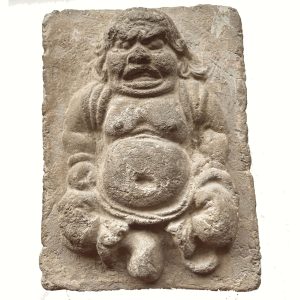
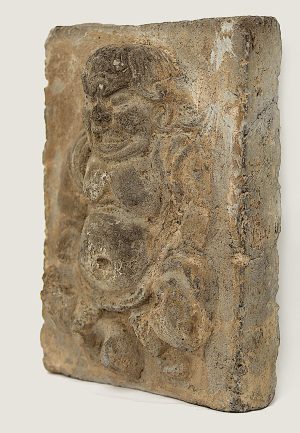
$475.00
H: 6.875” W: 5.25” D: 2.25 | FREE SHIPPING
This fascinating thick Song pottery brick is a low-fired depiction of a dwarf foreigner with a rotund belly, a large head and nose, an open mouth and abnormal features. The Chinese believed dwarfs could ward off evil spirits and sickness, attract peace and blessings (fu) and were very wise. Images of dwarfs became so popular, some were produced in numbers.
-
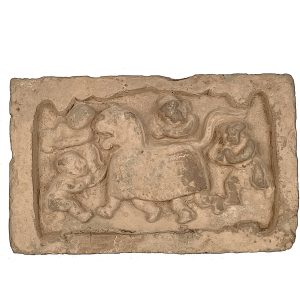
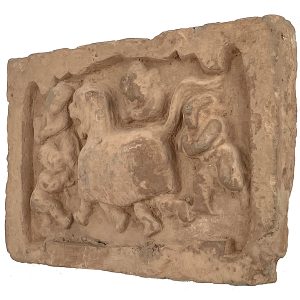
$495.00
H: 7.25” W: 11.5” D: 1.75” | FREE SHIPPING
This animated scene depicts the traditional Chinese Lion Dance performed at Chinese New Year, weddings, other important events and to honor guests, bring prosperity, happiness, good luck and ward off evil spirits. During the Song Dynasty tiles adorned the wall of tombs as well as government and important buildings with depictions of celebrations, mythology and deities and often included mythical animals, plants, vegetation and other auspicious objects.
-
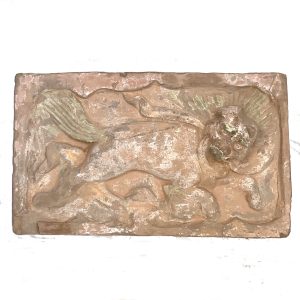
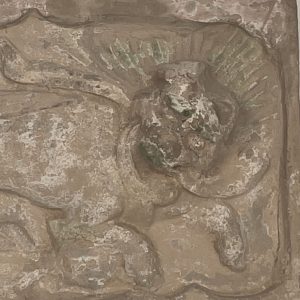
$485.00
H: 6.25” W: 10.125” D: 2.5” | FREE SHIPPING
This Song dynasty pottery brick tile depicts a pixiu, a mythical and a powerful feng shui symbol of wealth that brings money and good fortune and protect people from losing wealth. This fantastic winged creature has a dragon’s tail and head and a lion’s with an intensely angry expression to protect its master and his wealth and possessions. There is a rare handprint of the artisan who created it on the rear.
End of content
End of content























